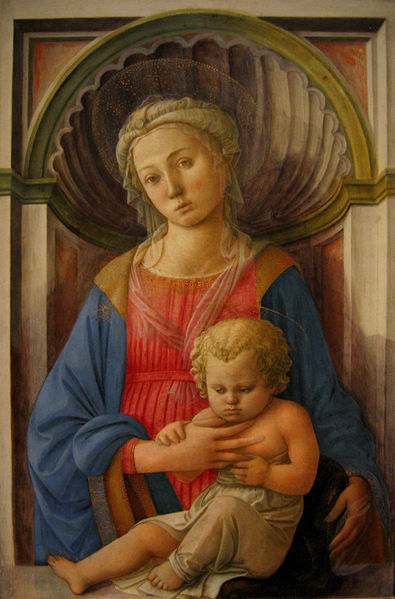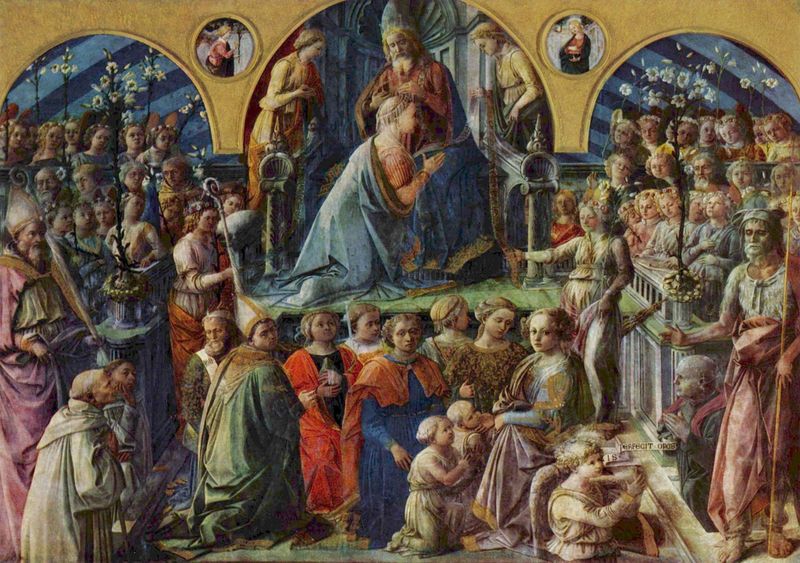Fra’ Filippo Lippi (1406-1469)
Get a Fra’ Lippi Certificate of Authenticity for your painting (COA) for your Fra’ Lippi drawing.
For all your Fra’ Lippi artworks you need a Certificate of Authenticity (COA) in order to sell, to insure or to donate for a tax deduction.
Getting a Fra’ Lippi Certificate of Authenticity (COA) is easy. Just send us photos and dimensions and tell us what you know about the origin or history of your Fra’ Lippi painting or drawing.
If you want to sell your Fra’ Lippi painting or drawing use our selling services. We offer Fra’ Lippi selling help, selling advice, private treaty sales and full brokerage.
We have been authenticating Fra’ Lippi and issuing certificates of authenticity since 2002. We are recognized Fra’ Lippi experts and Fra’ Lippi certified appraisers. We issue COAs and appraisals for all Fra’ Lippi artworks.
Our Fra’ Lippi paintings and drawings authentications are accepted and respected worldwide.
Each COA is backed by in-depth research and analysis authentication reports.
The Fra’ Lippi certificates of authenticity we issue are based on solid, reliable and fully referenced art investigations, authentication research, analytical work and forensic studies.
We are available to examine your Fra’ Lippi painting or drawing anywhere in the world.
You will generally receive your certificates of authenticity and authentication report within two weeks. Some complicated cases with difficult to research Fra’ Lippi paintings or drawings take longer.
Our clients include Fra’ Lippi collectors, investors, tax authorities, insurance adjusters, appraisers, valuers, auctioneers, Federal agencies and many law firms.
We perform Fra’ Filippo Lippi art authentication, appraisal, certificates of authenticity (COA), analysis, research, scientific tests, full art authentications. We will help you sell your Fra’ Filippo Lippi or we will sell it for you.

Fra’ Filippo Lippi, also called Lippo Lippi, was a well-known Florentine painter of the Italian 15th century school. Lippi was born in Florence to Tommaso, a butcher. Both his parents died while he was a child. His aunt, Mona Lapaccia, then took charge of the boy till 1420, when, at the age of fourteen, he was registered in the community of the Carmelite friars of the Carmine in Florence, Here he remained till 1432. Vasari, in his Lives of the Artists says: “Instead of studying, he spent all his time scrawling pictures on his own books and those of others, and so eventually the prior decided to give him every chance and opportunity of learning.” Eventually Fra Filippo quit the monastery, but it appears that he was not relieved from some sort of religious vow; in a letter dated in 1439 he speaks of himself as the poorest friar of Florence, and says he is charged with the maintenance of six marriageable nieces. In 1452 he was appointed chaplain to the convent of S. Giovannino in Florence, and in 1457 rector (Rettore Commendatario) of S. Quirico at Legania, and his gains were considerable and uncommonly large from time to time; but his poverty seems to have been chronic, the money being spent, according to one account, in frequently recurring amours.

Vasari relates some romantic adventures of Fra Filippo, which modern biographers are not inclined to believe. Except through Vasari, nothing is known of his visits to Ancona and Naples, and his intermediate capture by Barbary pirates and enslavement in Barbary, whence his skill in portrait-sketching availed to release him. This relates to a period, 1431-1437, when his career is not clearly accounted for. The doubts thrown upon his semi-marital relations with a Florentine lady appear, however, to be somewhat arbitrary; Vasari’s account is circumstantial, and in itself not greatly improbable.

Towards June 1456 Fra Filippo was settled in Prato (near Florence) to paint frescoes in the choir of the cathedral. Before actually undertaking this work he set about painting, in 1458, a picture for the convent chapel of S. Margherita of Prato, and there saw Lucrezia Buti, the beautiful daughter of a Florentine, Francesco Buti; she was either a novice or a young lady placed under the nuns’ guardianship. Lippi asked that she might be permitted to sit to him for the figure of the Madonna (or it might rather appear of S. Margherita); he made passionate love to her, abducted her to his own house, and kept her there despite the utmost efforts of the nuns to reclaim her.

The fruit of their loves was a boy, who became the painter, not less celebrated than his father, Filippino Lippi. Such is substantially Vasari’s narrative, published less than a century after the alleged events; it is not refuted by saying, more than three centuries later, that perhaps Lippo had nothing to do with any such Lucrezia, and perhaps Lippino was his adopted son, or only an ordinary relative and scholar. The argument that two reputed portraits of Lucrezia in paintings by Lippo are not alike, one as a Madonna in a very fine picture in the Pitti gallery, and the other in the same character in a Nativity in the Louvre, comes to very little; and it is reduced to nothing when the disputant adds that the Louvre painting is probably not done by Lippi at all. Besides, it appears more likely that not the Madonna in the Louvre but a S. Margaret in a picture now in the Gallery of Prato is the original portrait (according to the tradition) of Lucrezia Buti.

The frescoes in the choir of Prato cathedral, being the stories of the Baptist and of St Stephen, represented on the two opposite wall spaces, are the most important and monumental works which Fra Filippo has left, more especially the figure of Salome dancing, and the last of the series, showing the ceremonial mourning over Stephen’s corpse. This contains a portrait of the painter, but which is the proper figure is a question that has raised some diversity of opinion. At the end wall of the choir are S. Giovanni Gualberto and S. Alberto, and on the ceiling the four evangelists.

The close of Lippi’s life was spent at Spoleto, where he had been commissioned to paint, for the apse of the cathedral, some scenes from the life of the Virgin. In the semidome of the apse is Christ crowning the Madonna, with angels, sibyls and prophets. This series, which is not wholly equal to the one at Prato, was completed by Fra Diamante after Lippi’s death. That Lippi died in Spoleto, on or about the 8th of October 1469, is an undoubted fact; the mode of his death is again a matter of dispute. It has been said that the pope granted Lippi a dispensation for marrying Lucrezia, but that, before the permission arrived he had been poisoned by the indignant relatives either of Lucrezia herself, or of some lady who had replaced her in the inconstant painter’s affections. This is now generally regarded as a fable and indeed a vendetta upon a man aged sixty-three for a seduction committed at the already mature age of fifty-two seems hardly plausible. Fra Filippo lies buried in Spoleto, with a monument erected to him by Lorenzo the Magnificent; he had always been zealously patronized by the Medici family, beginning with Cosimo de Medici, Francesco di Pesello (called Pesellino) and Sandro Botticelli were among his most distinguished pupils.

In 1441 Lippi painted an altar-piece for the nuns of S. Ambrogio which is now a prominent attraction in the Academy of Florence, and has been celebrated in Brownings well-known poem. It represents the coronation of the Virgin among angels and saints, of whom many are Bernardine monks. One of these, placed to the right, is a half-length portrait of Lippo, pointed out by an inscription upon an angel’s scroll is perfecit opus. The price paid for this work in 1447 was 1200 Florentine lire, which seems surprisingly large.
For Germiniano Inghirami of Prato he painted the Death of St. Bernard, a fine specimen still extant. His principal altarpiece in this city is a Nativity in the refectory of S. Domenico — the Infant on the ground adored by the Virgin and Joseph, between Sts George and Dominic, in a rocky landscape, with the shepherds playing and six angels in the sky. In the Uffizi is a fine Virgin adoring the infant Christ, who is held by two angels; in the National Gallery, London, a Vision of St Bernard. The picture of the Virgin and Infant with an Angel, in this same gallery, also ascribed to Lippi, is disputable.

Lippo Lippi’s pictures show the naïveté of a strong, rich nature, redundant in lively and somewhat whimsical observation. He approaches religious art from its human side, and is not pietistic though true to a phase of Catholic devotion. He was perhaps the greatest colourist and technical adept of his time, with good draughtsmanship. As a naturalist, he had less vulgar realism than some of his contemporaries, and with much genuine episodic animation, including semi-humorous incidents and low characters. He made little effort after perspective and none for foreshortenings, was fond of ornamenting pilasters and other architectural features. According to Vasari, Lippi aimed to hide the extremities in drapery to avoid difficulties. His career was one of continual development, without fundamental variation in style or in coloring. In his great works the proportions are larger than life.
Still wondering about an Italian painting in your family collection? Contact us…it could be by Fra Filippo Lippi.
Reviews
1,217 global ratings
5 Star
4 Star
3 Star
2 Star
1 Star
Your evaluation is very important to us. Thank you.
